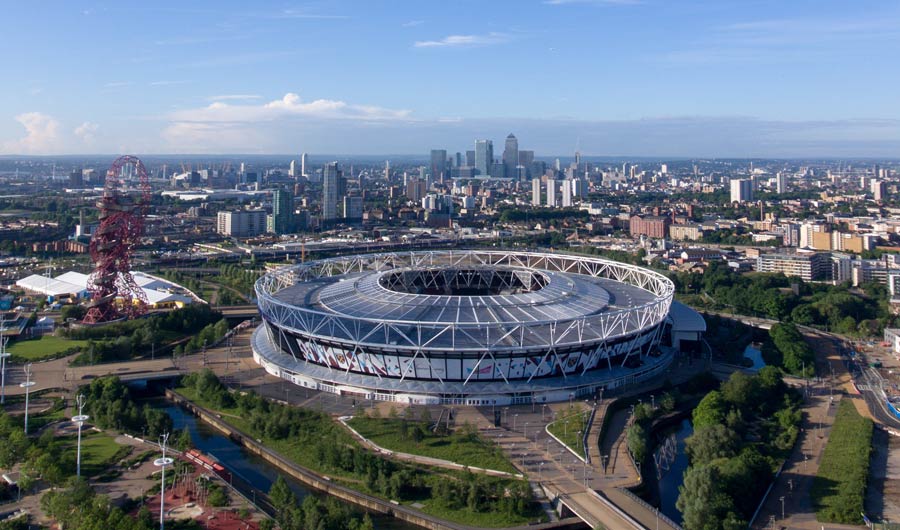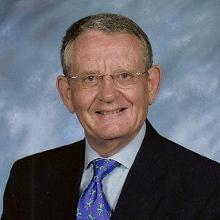Bringing Baseball to a Foreign Field

Aerial view of London Stadium, where the Boston Red Sox will play the New York Yankees in a two-games series the last weekend of June.
UAV 4 via Shutterstock
(Inside Science) -- When the Boston Red Sox and New York Yankees play a two-game American League series during the last weekend of June, the field will have a different look and an even more unusual location.
For the first time, the storied opponents will meet on artificial turf -- in the stadium that hosted the track and field events during the 2012 Olympic Games in London, England.
Ironically, both teams will wear their home uniforms, although the Red Sox are designated as the home team.
The series represents part of an effort by the MLB to increase the game’s appeal overseas. The league will repeat its “London Series” next year, matching the National League’s Chicago Cubs and St. Louis Cardinals.
Making the stadium baseball-friendly has demanded plenty of ingenuity in fieldwork and construction. MLB spokesman John Blundell said that the organization does not disclose the cost of the venture.
Murray Cook, the organization’s consultant who is overseeing the conversion, pointed out a key advantage in setting up the field. “We had a blank canvas; we could lay it out the way we wanted,” he said.
But his 200-person crew faces tight time constraints. “We have about 22 days total to build the pitch, three days for the games, and five days to remove it,” he added.
London Stadium contains a high-quality grass soccer field, on which local team West Ham United play during the English Premier League season, surrounded by an eight-lane running track.
So why not use the field as is?
“After the soccer season ends [in May], they cover the whole pitch for concerts and then regrow it in July,” Cook explained.
The cover consists of a deck of interlocked tiles. To prepare for the ballgames, Cook’s team has had to level the surface with gravel before covering it with the playing surface.
The crew originally hoped to use natural grass grown in England for that surface. But the tight schedule and the desire to reuse the surface for next year’s series played out in favor of artificial turf with the addition of rubber infill -- small, loose particles added to the surface to help raise the turf's fibers.
“After the games, we would have to pick up a grass field and throw it away. That’s not very sustainable,” Cook said. “We can use turf twice, and Major League Baseball can sell it.” The artificial turf may end up on a college or high school athletic field.
Even though the Red Sox and Yankees haven’t met on artificial turf, they’re both familiar with the surface. They play up to 20 games each season on synthetic grass when visiting American League East rivals Toronto Blue Jays and Tampa Bay Rays.
“I’m assuming it’s like Toronto’s or Tampa Bay’s, so it shouldn’t be an issue,” Yankees manager Aaron Boone told the MLB website. “If we had never played on turf it would be different,” agreed Red Sox shortstop Xander Bogaerts. “But we have.”
MLB has opted for 141,913 square feet of a brand called FieldTurf Vertex, made in Auchel, France, and transported to London by truck.
Other components of the ballfield originated in the United States. DuraEdge of Slippery Rock, Pennsylvania, supplied 345 tons of dirt for the infield and the engineered clay for the pitcher’s mound and home plate area.
“There’s a lot of science in defining what players and sports managers need in a clay; specific types of sand and clay can be designed to be better for your area,” Cook explained. His crew had considered using British clays, but decided that the American version fit their needs and schedule better.
The team also imported a soil conditioner from Turface Athletics of Buffalo Grove, Illinois. The conditioner prevents the synthetic turf and dirt becoming too slick after rain.
Fitting a baseball field into a stadium built for other sports gives sports architects a challenge. The setup measures 330 feet down the right and left field lines and a rather short 385 feet to straightaway center.
MLB’s rulebook specifies minimum distances of 325 feet down the lines and 400 feet to center, although fields with shorter dimensions built before 1958, such as the Red Sox’s Fenway Park, have been grandfathered in. A 16-foot high wall in London Stadium will compensate for the short center field dimension and increase the difficulty of crushing home runs in that direction.
Because MLB’s contract prevents the crew from drilling holes in the running track, the crew is using weights to secure the fences around the field.
Cook’s crew also had to guard against the danger that the two homer-happy teams will damage some of the stadium’s floodlights, which are set at lower levels than is typical in MLB ballfields.
To solve the problem, the crew lowered one of the lights, covered it with various materials, and fired baseballs at it from a pitching machine. Chicken wire proved to be the most protective and will surround the vulnerable lights on game days.
The stands that surround the field should be full. “Both games are complete sellouts,” said MLB’s Blundell. That means that a total of 120,000 fans will experience two authentic American games in an essentially English environment.

